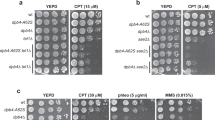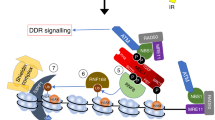Abstract
The CUL4–DDB1–ROC1 ubiquitin E3 ligase regulates cell-cycle progression, replication and DNA damage response1,2,3,4. However, the substrate-specific adaptors of this ligase remain uncharacterized. Here, we show that CUL4–DDB1 complexes interact with multiple WD40-repeat proteins (WDRs) including TLE1-3, WDR5, L2DTL (also known as CDT2) and the Polycomb-group protein EED (also known as ESC). WDR5 and EED are core components of histone methylation complexes that are essential for histone H3 methylation and epigenetic control at K4 or K9 and K27, respectively5,6,7, whereas L2DTL regulates CDT1 proteolysis after DNA damage through CUL4–DDB1 (ref. 8). We found that CUL4A–DDB1 interacts with H3 methylated mononucleosomes and peptides. Inactivation of either CUL4 or DDB1 impairs these histone modifications. However, loss of WDR5 specifically affects histone H3 methylation at K4 but not CDT1 degradation, whereas inactivation of L2DTL prevents CDT1 degradation but not histone methylation. Our studies suggest that CUL4–DDB1 ligases use WDR proteins as molecular adaptors for substrate recognition, and modulate multiple biological processes through ubiquitin-dependent proteolysis.
This is a preview of subscription content, access via your institution
Access options
Subscribe to this journal
Receive 12 print issues and online access
$209.00 per year
only $17.42 per issue
Buy this article
- Purchase on Springer Link
- Instant access to full article PDF
Prices may be subject to local taxes which are calculated during checkout





Similar content being viewed by others
References
Petroski, M. D. & Deshaies, R. J. Function and regulation of cullin–RING ubiquitin ligases. Nature Rev. Mol. Cell Biol. 6, 9–20 (2005).
Zhong, W., Feng, H., Santiago, F. E. & Kipreos, E. T. CUL-4 ubiquitin ligase maintains genome stability by restraining DNA-replication licensing. Nature 423, 885–889 (2003).
Higa, L. A., Mihaylov, I. S., Banks, D. P., Zheng, J. & Zhang, H. Radiation-mediated proteolysis of CDT1 by CUL4–ROC1 and CSN complexes constitutes a new checkpoint. Nature Cell Biol. 5, 1008–1015 (2003).
Higa, L. A. et al. Involvement of CUL4 Ubiquitin E3 ligases in Regulating CDK Inhibitors Dacapo/p27(Kip1) and Cyclin E Degradation. Cell Cycle 5, 71–77 (2006).
Sims, R. J., 3rd, Nishioka, K. & Reinberg, D. Histone lysine methylation: a signature for chromatin function. Trends Genet. 19, 629–639 (2003).
Craig, J. M. Heterochromatin — many flavours, common themes. Bioessays 27, 17–28 (2005).
Wysocka, J. et al. WDR5 associates with histone H3 methylated at K4 and is essential for H3 K4 methylation and vertebrate development. Cell 121, 859–872 (2005).
Higa, L. A. et al. L2DTL/CDT2 Interacts with the CUL4/DDB1 Complex and PCNA and Regulates CDT1 Proteolysis in Response to DNA Damage. Cell Cycle 5, 1675–1680 (2006).
Liu, C. et al. Transactivation of Schizosaccharomyces pombe cdt2+ stimulates a Pcu4-Ddb1-CSN ubiquitin ligase. EMBO J. 24, 3940–3951 (2005).
Hu, J., McCall, C. M., Ohta, T. & Xiong, Y. Targeted ubiquitination of CDT1 by the DDB1-CUL4A–ROC1 ligase in response to DNA damage. Nature Cell Biol. 6, 1003–1009 (2004).
Groisman, R. et al. The ubiquitin ligase activity in the DDB2 and CSA complexes is differentially regulated by the COP9 signalosome in response to DNA damage. Cell 113, 357–367 (2003).
Groisman, R. et al. CSA-dependent degradation of CSB by the ubiquitin-proteasome pathway establishes a link between complementation factors of the Cockayne syndrome. Genes Dev. 20, 1429–1434 (2006).
Wang, Q. E., Zhu, Q., Wani, G., Chen, J. & Wani, A. A. UV radiation-induced XPC translocation within chromatin is mediated by damaged-DNA binding protein, DDB2. Carcinogenesis 25, 1033–1043 (2004).
Smith, T. F., Gaitatzes, C., Saxena, K. & Neer, E. J. The WD repeat: a common architecture for diverse functions. Trends Biochem. Sci. 24, 181–185 (1999).
Neer, E. J., Schmidt, C. J., Nambudripad, R. & Smith, T. F. The ancient regulatory-protein family of WD-repeat proteins. Nature 371, 297–300 (1994).
Shiyanov, P., Nag, A. & Raychaudhuri, P. Cullin 4A associates with the UV-damaged DNA-binding protein DDB. J. Biol. Chem. 274, 35309–35312 (1999).
Couture, J. F., Collazo, E. & Trievel, R. C. Molecular recognition of histone H3 by the WD40 protein WDR5. Nature Struct. Mol. Biol. 13, 698–703 (2006).
Jennings, B. H. et al. Molecular recognition of transcriptional repressor motifs by the WD domain of the Groucho/TLE corepressor. Mol. Cell 22, 645–655 (2006).
Denisenko, O., Shnyreva, M., Suzuki, H. & Bomsztyk, K. Point mutations in the WD40 domain of Eed block its interaction with Ezh2. Mol. Cell Biol. 18, 5634–5642 (1998).
Ruthenburg, A. J. et al. Histone H3 recognition and presentation by the WDR5 module of the MLL1 complex. Nature Struct. Mol. Biol. 13, 704–712 (2006).
Dou, Y. et al. Physical association and coordinate function of the H3 K4 methyltransferase MLL1 and the H4 K16 acetyltransferase MOF. Cell 121, 873–885 (2005).
Scacheri, P. C. et al. Genome-wide analysis of menin binding provides insights into MEN1 tumorigenesis. PLoS Genet. 2, e51 (2006).
Zou, L., Cortez, D. & Elledge, S. J. Regulation of ATR substrate selection by Rad17-dependent loading of Rad9 complexes onto chromatin. Genes Dev. 16, 198–208 (2002).
Czermin, B. et al. Drosophila enhancer of Zeste/ESC complexes have a histone H3 methyltransferase activity that marks chromosomal Polycomb sites. Cell 111, 185–196 (2002).
Tie, F., Prasad-Sinha, J., Birve, A., Rasmuson-Lestander, A. & Harte, P. J. A 1-megadalton ESC/E(Z) complex from Drosophila that contains polycomblike and RPD3. Mol. Cell Biol. 23, 3352–3362 (2003).
Cao, R. & Zhang, Y. The functions of E(Z)/EZH2-mediated methylation of lysine 27 in histone H3. Curr. Opin. Genet. Dev. 14, 155–164 (2004).
Cao, R. et al. Role of histone H3 lysine 27 methylation in Polycomb-group silencing. Science 298, 1039–1043 (2002).
Lander, E. S. et al. Initial sequencing and analysis of the human genome. Nature 409, 860–921 (2001).
Li, D. & Roberts, R. WD-repeat proteins: structure characteristics, biological function, and their involvement in human diseases. Cell Mol. Life Sci. 58, 2085–2097 (2001).
Jia, S., Kobayashi, R. & Grewal, S. I. Ubiquitin ligase component Cul4 associates with Clr4 histone methyltransferase to assemble heterochromatin. Nature Cell Biol. 7, 1007–1013 (2005).
Angers, S. et al. Molecular architecture and assembly of the DDB1–CUL4A ubiquitin ligase machinery. Nature 443, 590–593 (2006).
Jin, J., Arias, E. E., Chen J., Harper, J. W. & Walter, J. C. A family of diverse Cul4–Ddb1-interacting proteins includes Cdt2, which is required for S phase destruction of the replication factor Cdt1. Mol. Cell 23, 709–721 (2006).
Acknowledgements
This work was supported by the grants from National Institutes of Health to H.S. (CA77695) and H.Z. (CA72878 and CA98955). H.Z. was also supported in part by an US Army grant (W81XWH-04-1-0230). H.S. and H.Z. would like to thank the members of the Sun and Zhang laboratories for discussions, R.K. for mass spectrometry, and T.Y and J. Guan for sequence alignments. The 293 suspension cells were from the Cell Culture Centre (Cellex Sciences, Minneapolis, MN).
Author information
Authors and Affiliations
Corresponding author
Ethics declarations
Competing interests
The authors declare no competing financial interests.
Supplementary information
Supplementary Information
Supplementary Figures S1, S2 and S3 (PDF 113 kb)
Rights and permissions
About this article
Cite this article
Higa, L., Wu, M., Ye, T. et al. CUL4–DDB1 ubiquitin ligase interacts with multiple WD40-repeat proteins and regulates histone methylation. Nat Cell Biol 8, 1277–1283 (2006). https://doi.org/10.1038/ncb1490
Received:
Accepted:
Published:
Issue Date:
DOI: https://doi.org/10.1038/ncb1490
This article is cited by
-
Deciphering the role of neddylation in tumor microenvironment modulation: common outcome of multiple signaling pathways
Biomarker Research (2024)
-
RepID represses megakaryocytic differentiation by recruiting CRL4A-JARID1A at DAB2 promoter
Cell Communication and Signaling (2023)
-
Genetic requirements for repair of lesions caused by single genomic ribonucleotides in S phase
Nature Communications (2023)
-
AUTS2 Controls Neuronal Lineage Choice Through a Novel PRC1-Independent Complex and BMP Inhibition
Stem Cell Reviews and Reports (2023)
-
A novel variant in TLE6 is associated with embryonic developmental arrest (EDA) in familial female infertility
Scientific Reports (2022)



